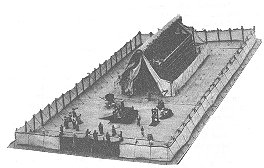tabernacle
tabernacle
Studies
Welcome to the studies section, this is a study of the Tabernacle.
This website is part of Watton on the web please take your time and look at the rest of the content we have available.
THE TABERNACLE
Where to start that's probably the toughest question. There seems to be so many different views and thoughts on this subject, that it would be impossible to try to convey all of them. So let me start by apologising for all the things that are left out of this study. What we are trying to do here is to look at the Tabernacle as a pattern for coming into Gods presence that would apply to us today. The problem with this is that much of the symbolism can be subjective or seeking to be original and there by create comparisons that are untenable and leave us empty. A famous quote by John Carter about the tabernacle said "We should be aware of typology in scripture but avoid tripe-ology", this must be our aim. Yet, I feel sure that as we explore the scriptures together using the New International Version, we will find ourselves guilty of making many of the same errors mentioned above.
Let's look at the words for tabernacle in both Hebrew and Greek.
The Hebrew words
OHEL - tent denoting a cloth roof
MISHKAN - residence denoting wooden walls/frame of the structure.
The Greek word
SKENE means tent, booth, or any habitation made of green boughs, skin, cloth, etc.

Shick's model of the tabernacle
From the picture above we can see the overall layout of the Tabernacle, according to Shick's model. The inner booth "Mishkan", is covered by an outer tent "Ohel". All this within the courtyard formed by the white linen curtain. The overwhelming sense given by these words is that of a portable dwelling place, in Exodus 25:8 the LORD said to Moses "let them make Me a sanctuary, that I may dwell among them." Hence, the Tabernacle was the place where Yahweh dwelt and met with His people after the exodus from Egypt. It later became the prototype of subsequent Jewish temples, because it was not designed by man but by God. Exodus 25:9 says " Make this tabernacle and all its furnishings exactly like the pattern I will show you."
The thing that makes any study of the tabernacle exciting is the thought that not only did God design the tabernacle but that it is a copy and a shadow of what is in heaven. Hebrews 8:5 says "who serve the copy and the shadow of the heavenly things, as Moses was divinely instructed when he was about to make the tabernacle. For He said 'see that you make all things according to the pattern shown you on the mountain'." The earthly tabernacle was therefore a reflection of present realities in heaven.
Many people have heard of the ten commandments, in fact many try to live their lives by them, yet if you asked those same people if they also tried to live by the regulations of the tabernacle, those same people would think you mad. But yet, the fact is when God gave the ten commandments, He also gave instructions for the house of worship. Moses was given detailed plans for a sacred structure designed as a necessary companion to the moral law. God made it clear that the moral demands of the ten commandments and the regulations concerning the architecture, furniture, and offerings of the tabernacle were different sides of one collective rule of life for Israel. The ten commandments revealed the high and holy standards of God. The tabernacle and everything associated with it, on the other hand, set forth Gods plan for living with and loving those who habitually fell short of his perfect rule of life.
Let us continue our study by examining the two areas of architecture and furniture
Before we draw together any conclusions about the object of our study in to the tabernacle and see how it speaks to us about coming into God's presence today. The most comprehensive source of information about the tabernacle is Exodus 25 - 28 where detailed instructions are given for the construction of the sanctuary and its furniture. Yet these details are incomplete, making an accurate reconstruction almost impossible. Exodus 35 - 40 describes the task of building the structure, since the tabernacle was the model for subsequent temples, the specifications given in 1 Kings 6 and 2 Chronicles 3 - 4 are an aid to understanding its function and certain details, as well as Ezekiel 41 - 43. Plus in the New Testament Hebrews 8 - 9 explains the shadow and the substance of the tabernacle.